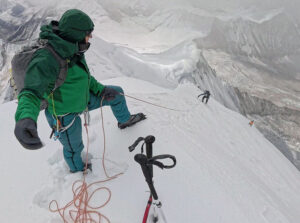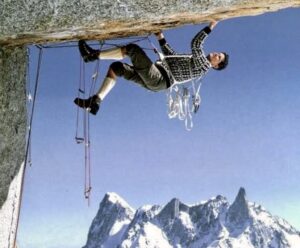The images and videos of Manaslu’s real summit have shaken the foundations of high-altitude climbing history. The controversy has been resolved into three key questions.
Question #1: What do we do with the stats?
Tobias Pantel of Himalayan Database said that Monday marked the first actual summits of Manaslu since Guy Cotter led his Adventure Consultants’ group in spring 2012, a route that Cotter himself described in ExplorersWeb’s Manaslu Climber’s Guide. The first question that then arises is, What do we do with the hundreds of “summits” recorded since then.
Likewise, many pre-2012 summits were surely just foresummits. While most climbers are surely satisfied with how far they reached, others need summit proof to validate records or their 14×8,000m lists. Should we review all records and reassess achievements? As for the list of Manaslu summiters over the last nine years, do we just delete them all?

The one previous autumn summit on Manaslu, reached by Jun Kageyama of Japan, J. M. Assadi of Iran, and Pasang Sherpa of Nepal in 1976. Photo: Jun Kageyama Col.
The Himalayan Database team has confirmed that “this is the second time this point was reached during the autumn season and the first time [in fall] since 1976.”
The Himalayan Database will now “sit together to come up with a strategy on how to deal with future and past summits of the world’s eighth highest peak,” they added.
It will be a difficult and contentious discussion. If past summits are invalidated, we will need to change many mountaineering records. We are not only talking of recent ones, such as Nirmal Purja’s fastest 14x8000m (done when the distinction between foresummit and summit on Manaslu was well-known). To name a few others, Edurne Pasaban, the first woman to climb all 14x8000ers, climbed Manaslu in fall, 2008; Adrian Ballinger’s first complete ski descent in fall, 2011; climbing speed records by Andrej Bargiel in 2014 and then Francois Cazzanelli in 2019. All invalid, or at least, under an asterisk. And the list goes on and on.

Dawa Yangzun, right, on the summit of Manaslu, her fifth “real” 8,000’er. Left, Mingma G and Kilu Sherpa. Photo: Dawa Yangzum
On the other side, if such records were nullified, or a parallel “modern” list begun, we could witness a new race for firsts. For Instance, the four women in Imagine Nepal’s team who reached the main summit (some are not yet confirmed) would surely become the first national ascents…and position themselves for something more? Nepali-born U.S. national Dawa Yangzum, an IFMGA guide on the Imagine Team, now has five 8,000m peaks under her belt, with surely more to come.
Question #2: Why not go to the main summit?
The second question is why so many people stopped shy of the top? Some past climbers really believed that they were at the highest point. Ralf Dujmovits, for example, knew that the usual endpoint was not the summit. He proceeded farther but still didn’t reach the highest point.
Many others probably chose not to double-check. Moreover, through the years the place where the ropes ended, the so-called summit, has varied. Photos from 2013 show that climbers reached what 8000ers.org researchers call C2. Lately, they have stopped even lower, at a point known as Shelf 2 (see photo below). With ever-larger teams and less experienced clients, leaders considered that Shelf 2, located at a corniced area before the start of the final arete, was enough.

Ralf Dujmovits climbs past Shelf 2 toward the C2 bump, which he thought was the true summit — but was not. Photo: @RalfDujmovits/Info by Tobias Pantel
Through mountaineering history, many seasoned climbers have written in their memoirs that Manaslu is not technically difficult. Perhaps they missed the final crux section? Others remember a technical, exposed section at the end. But did they cover the whole section to the highest point or make the same mistake as Dujmovits?
After years of rumors, doubts, and silences, it’s surely time to discuss this openly and reach some relative agreement. It affects everyone who ever climbed Manaslu. Each case is different, and yet, there is only one summit.

The situation on Sep 27, 2021. The red circle marks Shelf 2. This is where everyone except the Imagine Nepal group stopped. The yellow circle shows the C2 foresummit. Photo: Jackson Groves/Instagram/Info by Tobias Pantel
Which leads to the third question:
Question #3: Now what?
Even after the research by 8000ers.org appeared, some climbers spoke of zones of tolerance and irrelevant differences in altitude. But Mingma G’s imagery and most of all, Jackson Groves’ drone footage (taken from his own endpoint, the foresummit) has invalidated these arguments. From a bird’s-eye view, the difference between the usual foresummit and the true summit is anything but irrelevant. The last bit is exposed, difficult, and scary. Just like an 8,000m peak should be.

Another shot of Manaslu’s summit ridge on September 27, 2021. It shows climbers stopping at the end of the ropes, still a long way from the summit. Meanwhile, Mingma G’s team traverses a lower route below the west side of the ridge. Photo: Jackson Groves/Instagram
We now know where the summit is, with no room for doubt. We know that some climbers reached it. We know it’s difficult, and depending on conditions, sometimes too risky. Finally, we must assume that Manaslu is no longer “one of the easiest” 8,000’ers. Surely now, anyone hoping to be credited with climbing Manaslu should attempt that summit.
The Himalayan Database shares that point of view in their latest official report. For the time being, they “congratulate all the teams that reached the foresummit” recently.
For obvious reasons, Nepal’s Department of Tourism has been avoiding the summit controversy for years, especially in 2016. They have issued certificates for anyone who reached any point close to the summit area. It remains to be seen what they will do now. Most probably, near-summiters will still receive summit documents, but that paper will lose most of its value.
More Manaslu summits to come?
The situation is particularly awkward for the nearly 300 climbers (Nepalis and foreigners) who recently were or are still on the mountain. Last Monday, as climbers queued for a “summit photo” at the end of the ropes, Mingma G and his team headed for the real summit, not knowing that a drone was recording them. Ironically, the drone pilot didn’t know either (!) — but he changed mountaineering history.
On the following two days, many more climbed toward the upper slopes from Camps 3 and 4. As far as we know, none of them followed Imagine Nepal’s footprints to the summit. It is not impossible that some of those climbers were unaware that a single team had stepped off the mainstream route and broken the trail to genuine mountaineering glory.
As the news spread, the social media accounts of the climbers who stopped where the ropes ended received many reader questions about whether they only reached a foresummit and why. Some of them took it pretty badly, to judge from their replies. But none changed their plans and took their clients to the actual summit. Not even the strongest ones decided to silence the critics by reaching the indisputable summit.
This, of course, might change.
Meanwhile, many climbers still wait in Base Camp. While the weather forecast for the next several days is poor, we’re just midway through the autumn season. Mingma G broke the trail to the summit and Jackson Groves showed the route and visual evidence of why it matters. The rest is up to those on their way up.






